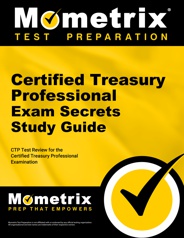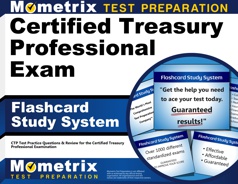Certified Treasury Professional (CTP) Exam evaluates a candidate’s knowledge and ability to handle critical functions related to corporate liquidity, capital, and risk management. The CTP credential is recognized around the world as the leading credential in corporate treasury, with holders earning an average of 16% more than non-holders.
Click “Start Test” above to take a free Certified Treasury Professional practice test, and check out our premium-quality Certified Treasury Professional test prep resources by clicking the links below!
Certified Treasury Professional Exam Eligibility
Candidates wanting to take the CTP will have to meet the educational or work experience requirements before they can do so.
All candidates must have one of the following:
- Two years of experience working full-time in an area of professional finance
- A graduate degree in finance
- Four years of full-time college-level financial teaching experience
Certified Treasury Professional Exam Outline
The Certified Treasury Professional Exam contains 170 questions, all of which are multiple-choice, and the time limit is 3.5 hours.
The exam contains 5 domains, which are outlined below.
Domain 1 (37-41 questions)
This domain is about maintaining corporate liquidity required to meet current and future obligations in a timely and cost-effective manner.
Specifically, Domain 1 covers the following topics:
- Managing optimal cash positioning through short-term investing and borrowing
- Managing cash receipts and disbursements
- Managing optimal banking structure
- Managing trade financing
- Managing foreign exchange exposure
- Optimizing treasury operations
- Managing intercompany financing
- Ensuring accuracy by reviewing cash balances and reconciling transaction activity
- Optimizing financial decision-making by calculating, analyzing, and evaluating financial ratios
Domain 2 (27-31 questions)
This domain is about managing capital structure, managing costs of long-term capital, and quantitatively evaluating long-term capital resource investments.
Specifically, Domain 2 covers the following topics:
- Negotiating and managing syndicated agreements
- Managing investment portfolios
- Managing issuance of debt and equity
- Managing revolving debt agreements
- Assessing the impact of mergers, divestitures, and acquisitions
- Evaluating current market conditions as they relate to long‐term borrowing strategies
- Administering dividends, issue, or repurchase of stock
- Hedge FX, commodities exposure, and interest rate
Domain 3 (27-31 questions)
This domain is about managing internal and external relationships.
Specifically, Domain 3 covers the following topics:
- Building, maintaining, and reviewing relationships with external financial service providers
- Evaluating and implementing treasury products and services
- Maintaining documentation and administering bank accounts
- Ensuring best practices and competitive pricing by identifying, negotiating, and selecting relationships and operational agreements with external service providers
- Serving as an internal trusted advisor and consultant
- Managing merchant services programs
- Building and maintaining relationships with internal stakeholders
Domain 4 (31-35 questions)
This domain is about monitoring and controlling corporate exposure to financial, regulatory, and operational risk (including emerging and reputational risk).
Specifically, Domain 4 covers the following topics:
- Complying with treasury policies and procedures
- Drafting treasury policies and procedures for approval
- Detecting and mitigating fraud
- Ensuring best practices by benchmarking performance against external sources
- Evaluating and managing counterparty risk
- Developing, maintaining, and testing business continuity plans
- Managing merchant services programs
- Ensuring regulatory compliance, and reporting internally and externally on compliance
Domain 5 (17-20 questions)
This domain is about assessing impact of technologies on the treasury function.
Specifically, Domain 5 covers the following topics:
- Leveraging technology systems
- Identifying security issues and concerns associated with new and existing technology
- Monitoring information security risks and cyber‐related risks
Check Out Mometrix's Certified Treasury Professional Study Guide
Get practice questions, video tutorials, and detailed study lessons
Get Your Study Guide
How to Pass
Think you aren’t a good test-taker? Maybe on a study-time crunch? Or just don’t know how to begin studying? Mometrix has designed a new Study Secrets course to help every student, no matter what study scenario you are in. Here’s what you’ll find in the Study Secrets Course:
- Techniques to Conquer Procrastination
- Steps to building a Study Plan custom to your learning style
- 7 Effective Note-Taking Methods
- Test-Taking Tips
- Memory Techniques and Mnemonics
- And much more!
Everyone learns differently, so we’ve tailored our Study Secrets Course to ensure every learner has what they need to prepare for their upcoming exam or semester. Click below to check it out!
Registration
Registration for the exam is done online or over the phone. To successfully register, you will have to pay a registration fee of $186.
| Phone: | To make your registration over the phone, call Pearson VUE’s registration center at 866-837-8287. |
| Online: | For online registration, visit the Pearson VUE website. |
Receiving Authorization
After you have registered online or over the phone, you will wait to receive authorization to take the test via the mail. Your authorization should arrive within a month of your registration. If you do not receive the authorization in the mail in a month, call 301-907-2862 or reach out to certification@afponline.org.
Candidates who registered to take the test at a later date will NOT receive their authorization to test in the mail until after the current test date has passed.
When you receive your authorization letter, take the time to ensure the name on the paper is an exact match to your method of identification. If you see any incorrect information, contact AFP as soon as possible to have the error corrected. On test day, you will not be allowed to test if the name on your ID and the name on the authorization are not exact matches.
Choosing a Testing Center
Once you receive your authorization, you can register to take the test at any of the 5,000 centers. You want to do this as soon as you receive your letter. The available seats at these centers fill up quickly, so you do not want to miss your opportunity by waiting to declare where you want to test!
Cancelling Your Registration
If you contact the AFP by sending them the appropriate required form to cancel by the deadline, you will receive a portion of your fee, but not all of your registration fees. The deadlines for cancellation requests are always 14 days before the registered testing day.
CTP Fees
All test fees are in addition to the initial registration fee.
If you are a member of the Association for Financial Professionals (AFP), the cost of the test is $1,025 ($925 for early registration). The cost for non-AFP members is $1,420 ($1,320 for early registration.
Test Day
To be admitted to take the exam, you must provide a valid photo ID. Examples of acceptable identification include passports, state-issued driver’s licenses, state-issued identifications, and employee cards that have your name and photo.
Items that are NOT Allowed in the Testing Room
- Cell phone
- Handheld calculator (online calculators will be provided)
- Books or reference materials
- Scratch paper (you will be given a whiteboard and pen to do your calculations on)
Late Arrival
If you arrive at the testing center more than 30 minutes after the test has begun, you will be considered a “no-show.” No-shows are penalized with an $85.00 fee.
CTP Scores
To pass the CTP exam, candidates must earn a score of 300 or above. It may be comforting for you to know that at least 50% of the candidates who take the exam receive a passing grade!
If take the computer-based test, you will receive an unofficial score report immediately after you complete the test. Regardless of the testing method, official score reports are sent out about 3 weeks after you complete the test.
Retaking the Exam
There are no limitations to how many times you can take the examination overall, but you can only take the exam once during each exam window.
Check Out Mometrix's Certified Treasury Professional Study Guide
Get complex subjects broken down into easily understandable concepts
Get Your Flashcards
How to Study Effectively
Your success on CTP test day depends not only on how many hours you put into preparing but also on whether you prepared the right way. It’s good to check along the way to see whether your studying is paying off. One of the most effective ways to do this is by taking CTP practice tests to evaluate your progress. Practice tests are useful because they show exactly where you need to improve. Every time you take a free CTP exam practice test, pay special attention to these three groups of questions:
- The questions you got wrong
- The ones you had to guess on, even if you guessed right
- The ones you found difficult or slow to work through
This will show you exactly what your weak areas are and where you need to devote more study time. Ask yourself why each of these questions gave you trouble. Was it because you didn’t understand the material? Was it because you didn’t remember the vocabulary? Do you need more repetitions on this type of question to build speed and confidence? Dig into those questions and figure out how you can strengthen your weak areas as you go back to review the material.
Answer Explanations
Additionally, many Certified Treasury Professional practice tests have a section explaining the answer choices. It can be tempting to read the explanation and think that you now have a good understanding of the concept. However, an explanation likely only covers part of the question’s broader context. Even if the explanation makes sense, go back and investigate every concept related to the question until you’re positive you have a thorough understanding.
Comprehend Each Topic
As you go along, keep in mind that the CTP practice test is just that: practice. Memorizing these questions and answers will not be very helpful on the actual test because it is unlikely to have any of the same exact questions. If you only know the right answers to the sample questions, you won’t be prepared for the real thing. Study the concepts until you understand them fully, and then you’ll be able to answer any question that shows up on the test.
Strategy for CTP Practice
When you’re ready to start taking practice tests, follow this strategy:
- Remove Limitations. Take the first test with no time constraints and with your notes and CTP study guide handy. Take your time and focus on applying the strategies you’ve learned.
- Time Yourself. Take the second practice test “open book” as well, but set a timer and practice pacing yourself to finish in time.
- Simulate Test Day. Take any other practice tests as if it were test day. Set a timer and put away your study materials. Sit at a table or desk in a quiet room, imagine yourself at the testing center, and answer questions as quickly and accurately as possible.
- Keep Practicing. Keep taking practice tests on a regular basis until you run out of practice tests or it’s time for the actual test. Your mind will be ready for the schedule and stress of test day, and you’ll be able to focus on recalling the material you’ve learned.
FAQs
Q
How hard is the CTP exam?
A
The CTP exam is generally known to be a moderately difficult exam, with an average pass rate of 50%.
Q
How many questions are on the CTP exam?
A
There are 170 questions on the CTP exam.
Q
How long is the CTP exam?
A
The CTP exam has a time limit of 3.5 hours.
Q
What jobs can I get with a CTP credential?
A
Not all of the jobs listed below actually require a person to have passed the CTP exam, but if you plan to work in any of the positions listed here and have taken and passed this test will increase your chances of being hired.
- Treasury analyst
- Treasury managers
- Senior treasury analyst
- Treasurer
- Treasury director
- Senior treasury manager
- Assistant treasurer


